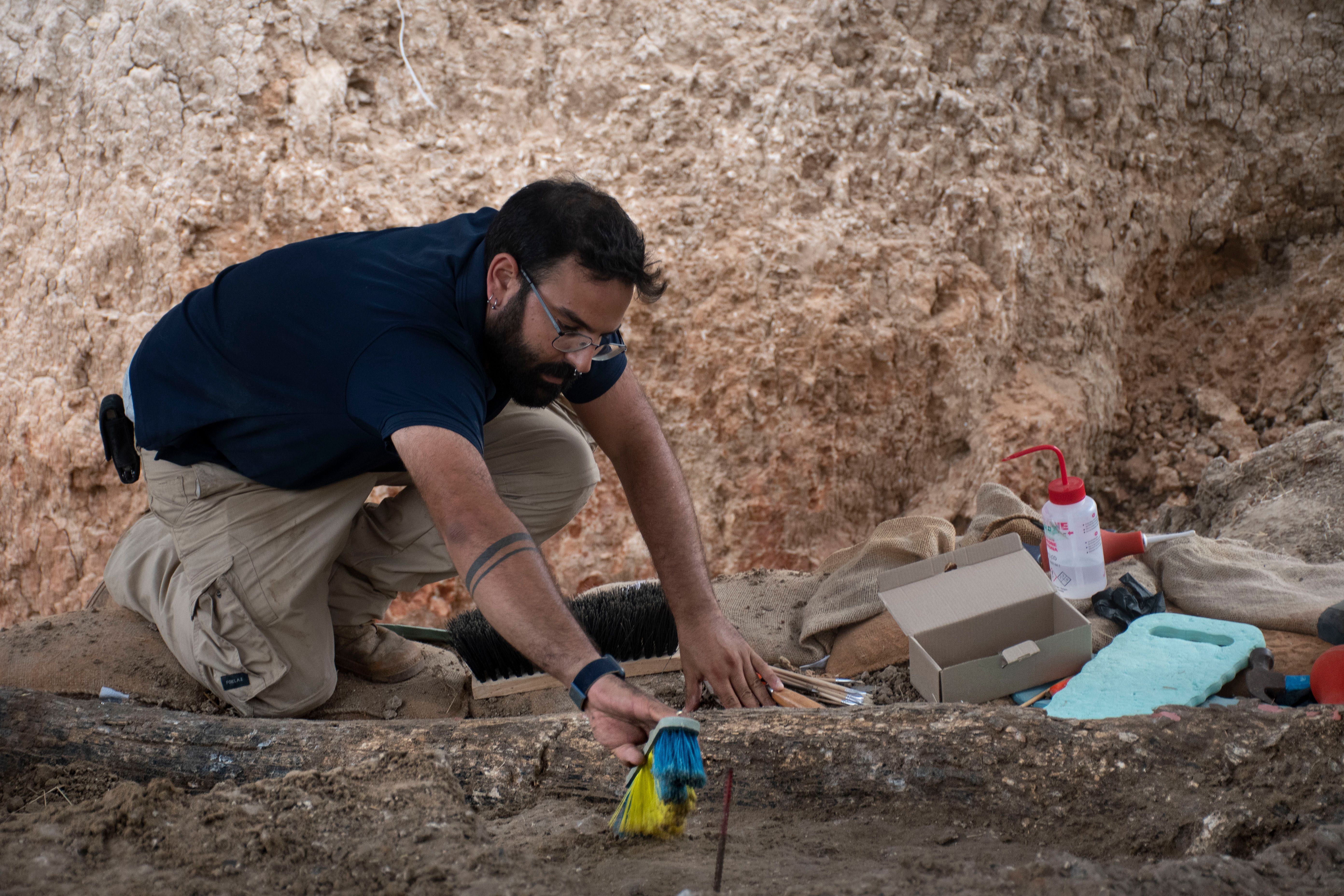In southern Israel, near the kibbutz of Revadim, there’s a half-million-year-old elephant graveyard. It dates back to when herds of the gigantic beasts roamed as far north as Great Britain, with only the odd early human hunting party to watch out for.
But these weren’t elephants as we know them today: they were Palaeoloxodon antiquus – the straight-tusked elephant. And it’s one of those tusks – a specimen measuring a whopping 2.5 meters (8.2 feet) long – which has recently been discovered by researchers working on a two-week investigation aptly named “Operation Elephant”.
“From our previous archaeological excavations at Revadim, we knew that the site was settled in the Late Lower Paleolithic period,” said Avi Levy, Israel Antiquities Authority prehistorian and director of the excavation in a statement sent to IFLScience. “But finding this half-a-million-year-old complete elephant tusk in such a good condition is something else!”

An archaeologist uncovering the tusk. Image credit: Yoli Schwartz, Israel Antiquities Authority
The new discovery is “the largest complete fossil tusk ever found at a prehistoric site in Israel or the Near East,” explained Levy. But it’s extremely fragile, making its excavation difficult even for experienced archeologists: exposure to human touch, or just air and sunlight, could be enough to make the entire artifact disintegrate.
“The tusk was subjected to an initial conservation treatment when it was first discovered,” said Israel Hershkovitz, a professor at the Dan David Center for Human Evolution and Biohistory at Tel Aviv University and one of the researchers involved in the dig. “Now we are excavating it within its archaeological context, before transferring it to the Israel Antiquities Authority Conservation Laboratory, where it will be studied and conserved.”
But the discovery isn’t just exciting for its size and quality – it also reveals some tantalizing insights into prehistoric human life. “The discovery of the tusk, detached from the skull and the rest of the body, raises questions,” explained Ofer Marder, a professor of archaeology at Ben-Gurion University, and Ianir Milevski, head of the Israel Antiquities Authority Prehistory Branch. “Is the tusk the remains of a hunted elephant, or was it collected by the local prehistoric inhabitants? Did the tusk have social or spiritual significance?”

It’s pretty large. Image credit: Israel Antiquities Authority
Elephants were known to be hunted along with other large mammals in the area – wild cattle, hippopotami, deer, wild boars, wild horses, and so on – but finding their remains in archaeological sites is rare. Previous excavations at the same site had already revealed smaller clues, like bits of elephant skulls, ribs, and teeth, as well as ancient flint tools used for processing animal flesh, such as flake tools, hand-axes, and chopping tools.
But elephants are famously large – and straight-tusked elephants were even more so, growing up to 4.5 meters, or nearly 15 feet, in height and weighing more than 14 tonnes. That’s even bigger and heavier than today’s African elephants, making the hunting and killing of one quite the feat.
Which raises a question that’s been debated for some time now: was elephant hunting a normal thing for our prehistoric ancestors? Or was it something reserved only for special occasions?
“We anticipate that the discovery of the new tusk in a clear archaeological context will shed light on this issue,” Hershkovitz said in the statement seen by IFLScience with the Israel Antiquities Authority’s Omry Barzilai.
“The concentration of the material remains – mostly stone tools – in the current excavation and at the entire site, indicates that there was a substantial number of people at the site in one period of time and that elephants were hunted,” they explained. “In the hot dry climate in our region, elephant’s meat could not stay fresh for long, so it must have been consumed quickly by many people, probably as part of a communal event.”
But regardless of the outcome – whether prehistoric humans were regularly chowing down on elephant sandwiches or if it was a rare celebration – the tusk is an incredible find, both for the academic community and for the public at large.
“Consequently, once the conservation process is completed, we plan to exhibit the tusk to the public in our permanent exhibition hall at the new Jay and Jeanie Schottenstein National Campus for the Archaeology of Israel in Jerusalem,” said Eli Eskozido, Director of the Israel Antiquities Authority.
Source Link: Colossal Half-Million-Year-Old Elephant Tusk Discovered In Southern Israel